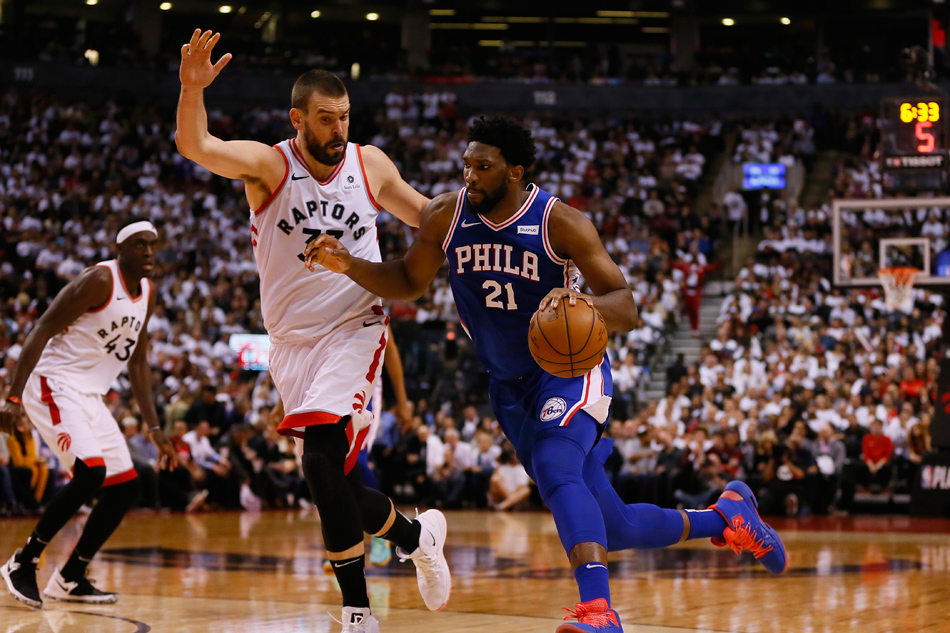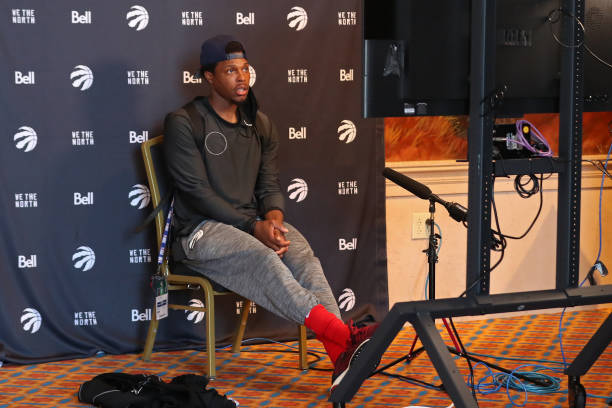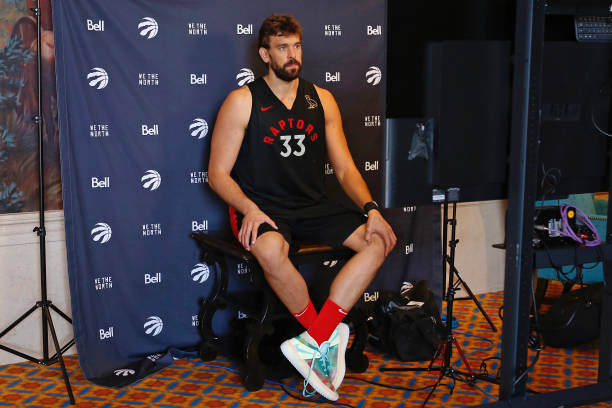This is the fourth entry in an ongoing series looking to predict how players and strategies of the Toronto Raptors will fare in the playoffs. You can find previous entries for Pascal Siakam, Fred VanVleet, and OG Anunoby.
Like the city of San Francisco, Marc Gasol’s basketball game seems to be built directly on a fault line. At this stage in his career, on most offensive possessions, he strays only a few feet from his office at the top of the key. He can no longer jump higher than a few inches, and he passes up shots with the aplomb of a late-career Dennis Rodman. Gasol averaged 7.6 points per game this season, which is by far the lowest of his career; in fact, among 30 starting centers, he averaged 27th in points per game, 26th in rebounds per game, and 24th in blocks per game. And yet Gasol remains a huge positive, according to advanced stats, with the highest net rating of any rotation Raptor. This is a team stat, so it’s not apples and apples, but Gasol had the second-highest defensive rating and second-highest net rating among starting centers.
The Raptors were at their best with Gasol on the floor. That’s a confounding fact when one considers his limited individual production. And that seeming paradox has been true all season. I turned to some old pieces I’ve written about Gasol this year, and in this November piece that was mostly about O Brother Where Art Thou and tangentially about basketball, I realized that Gasol’s presence was an important bellwether of Toronto’s success, even when his individual play seemed unremarkable. He had his moments, including a dominant performance in a January win over the Philadelphia Sixers, but he often looked bent under the weight of time.
So how, then, did he dominate?
Well first let’s differentiate between where Gasol dominated and where he didn’t. According to Cleaning the Glass, Gasol sported the team’s best on-off mark, but it wasn’t equal on both sides of the floor. He was only middling on the offensive end, adding on average 0.7 points per 100 possessions (sixth on the team and just ahead of his backup, Serge Ibaka). But on the defensive end, Gasol was in the 91st percentile league-wide, with the team’s defense 6.8 points stingier with him playing than not. Among players who played 980 minutes or more, that was 12th-best in the whole league.
An important informer of a player’s on-off stat is who replaces said player when he is off the court. For Gasol, that was usually Ibaka, but also sometimes Rondae Hollis-Jefferson, Pascal Siakam, and Chris Boucher. I should interject here. For the foreseeable future in this piece, it’s going to read like a ‘here’s why Gasol is better than Ibaka’ piece. That is only the case because that any evidence to that point goes a long way in unraveling the mystery of Gasol’s massive edge in advanced numbers. This piece is not at all meant to malign Ibaka; he’s a fantastic player and a luxury to bring off the bench. Alright, end of aside.
Offensively, it makes some sense that Gasol was a slight plus. He’s no longer an individual scorer the caliber of Ibaka, but he’s a capable shooter, a better screen-setter, and one of the best passers in the league at the center spot. The Raptors don’t ask for their centers to create a lot, and Gasol was terrific chipping in around the edges. That, also, is Ibaka’s strength, so it makes sense that Gasol’s offensive on-off would be mediocre. Another element that hurt Gasol’s offensive on-off: Toronto’s was unbelievable on offense when Siakam played without a center, likely in part because of Siakam’s incredible two-man game as a big alongside Kyle Lowry.
The main point though is that Gasol’s true strength is on the defensive end. He thinks the game at such a high level that he is seemingly always in the right place. He doesn’t get fooled by fluff. He has fast hands, and so is terrific at blitzing, trapping, and dropping, even if his feet are no longer speedy enough to allow him to switch onto guards. He is exceptionally strong and so doesn’t get outmuscled in the post. (All of those strengths are why he’s perfect engineered to stop Joel Embiid.) And most of those strengths are, at least among Raptors’ bigs, unique to him.
Consider more on-off stats, here all taken from Cleaning the Glass. These, more than any others, define why Gasol’s presence was so important to Toronto’s success.

When Gasol was on the floor versus off, teams missed more shots and committed turnovers. More important, they took far fewer free throws. Gasol was actually the second-best player in the league in that specific area of keeping opponents off the line. Gasol’s 2.8 fouls committed per game is not a particularly overwhelming number; plenty of other centers commit fewer fouls. But because of Gasol’s incredible positioning, his teammates commit fewer fouls when Gasol is on the floor.
To be fair, there are plenty of areas on defense in which Gasol is not better than Ibaka. According to the wonderful nbashotcharts dot com, Gasol and Ibaka allowed comparable shooting rates and percentages at the rim when they were on the floor, which is an important mark for a center. According to nba dot com, Ibaka was significantly better at forcing misses when he was the primary defender at the rim. These are important stats that have nothing to do with on-off marks. Ibaka’s on-off marks, by the way, were as good or better than Gasol’s for effective field percentage and turnover percentage. Ibaka is still a very talented center, and Toronto’s ability to bring him off the bench gives the Raptors a huge advantage over opponents. But Toronto’s defense posted better total numbers with Gasol in the game, and opponents’ free throw rate was a major reason why.
(Not to get too granular, but some of that is noise. Gasol played 53.2 percent of his possessions alongside the team’s other best defenders in Fred VanVleet and OG Anunoby. Ibaka played only 37.7 percent of his total possessions alongside them. And when Ibaka was alongside VanVleet and Ibaka, Toronto free throw rate per 100 field goal attempts was 88th percentile. Of course it’s not entirely on a center to keep opposing offenses off the free throw line. But Gasol has been 80th percentile or higher in on-off defensive free throw rate in 11 of 13 years in his career. Ibaka has reached that mark in six of his 12 years, so there’s something to Gasol being better at it other than minute share with teammates. Also, wow, the Raptors are lucky to have both. This aside is getting a little too far into the weeds, however.)
So it’s difficult to give all of the credit to Gasol for his on-off numbers. There are, of course, four other players on the court with him at all times. But Toronto’s defense is much better when he’s playing. Whether that’s entirely due to him is arguable.
Regardless, Toronto won 77.8 percent of its games in which Gasol played and only 64.3 percent of its games without Gasol. The difference is the same as that between the Los Angeles Lakers’ winning percentage (77.8 percent) and that of the Utah Jazz (64.1 percent). Without Gasol, Toronto was very good in other ways. They ran more, hit the offensive glass, and fought to the free throw line. When Siakam played center, Toronto’s offense was brilliant. When Hollis-Jefferson played center, opponents finished one out of every five possessions with a turnover. Toronto could shape-shift without Gasol. But they weren’t as winning a team.
Okay, that’s enough analysis for a simple prediction. Here goes: the Raptors will be really good when Gasol plays in the playoffs! He will continue to shoot a very few number of times a game, but he will impact the game in other ways, the Raptors will thrive with him on the court. Seems obvious.
But wait, that’s not all!
On top of the difficult question of how Gasol dominates despite his individual limitations, we are faced with a new variable that complicates predicting Gasol’s playoff performance. The chatter out of the Raptors’ bubble is focused on Gasol’s physical rejuvenation; we really don’t know what to expect. His lingering hamstring issues have healed. He looks trim and fit, and rumours are that he is dominating practices. Terence Davis said that “he looks like prime Marc.” Prime Marc, Raptors’ fans may remember, was one of the best NBA players in the league.
All of the nuanced complications could amount to little if indeed Gasol has turned back into his old self. If in the playoffs he averages almost 20 points and 10 rebounds again, he will no longer be built on a fault line but instead be an earthquake unto himself. The Raptors would, in all likelihood, be championship favourites if that player came to Orlando. Unfortunately for Toronto, those things rarely happen.
It’s doubtful that Gasol has spent the year holding himself back for the playoffs; last year, Gasol’s playoff numbers were virtually identical to his regular season numbers after his trade to Toronto. More likely is that as Gasol has had time to rest for the first time in a few years, he’ll be slightly more mobile on both ends of the court, and a little bit more willing to look for his own shot.I t’s possible we get slightly more of Gasol as a result of his rest. As in, him taking 12 shots a game instead of seven.
Anything more is a fantasy, though. Thirty-five-year-olds don’t magically become their 25-year-old selves, regardless of rest. No matter the chatter coming out of the Toronto bubble practices, Gasol will probably remain what we saw in the 2019-20 regular season. That means in some games, he will only attempt two or three shots and grab a similar number of rebounds. He will still somehow end those games, quite often, as Toronto’s best player in the plus-minus column. Something about Gasol is magic; the Raptors win when he plays. That’s life when your reality sits directly on top of the line between differing opinions. And that’s what to expect from Marc Gasol in the playoffs.



